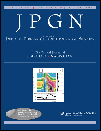CFC1 Gene Involvement in Biliary Atresia With Polysplenia Syndrome
The authors report no conflicts of interest.
ABSTRACT
The present report describes CFC1 gene analysis in 10 patients with polysplenia syndrome. The heterozygous transition c.433G>A (Ala145Thr) located in exon 5 was identified in 5 patients, with a twice-higher frequency than in control patients. These results suggest that heterozygous CFC1 mutation may represent a genetic predisposition to biliary atresia splenic malformation syndrome.




